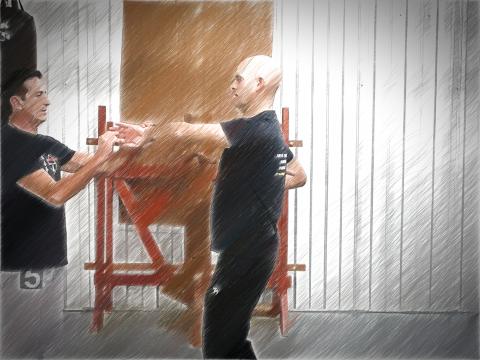The First Form, The Last Form of Wing Chun
March 25, 2024
“When the highest type of men hear the Way, with diligence they’re able to practice it; When average men hear the Way, some things they retain and others they lose;
When the lowest type of men hear the Way, they laugh out loud at it.
If they didn’t laugh at it, it couldn’t be regarded as the Way.” —Lao Tzu, Te-Tao Ching.
5 Min. Read
Meet the Author: Munawar Ali Karim chats about Wing Chun with Gene Ching (video)
February 28, 2024
British author Munawar Ali Karim chats about his new book Wing Chun In-Depth
Wing Chun is Alive and Well
July 17, 2023
The new China had turned its back on the glorious past. But the martial arts were a part of that past that could not easily be destroyed.
The Punch
June 12, 2023
“It is a must to practice the straight punches daily,” says Sifu Loukas. He insists that students should average around 2,000 punches a day in order to develop the coordination of both hands, accuracy, speed, and flow.
A Glove Day Lesson
May 22, 2023
“When the highest type of men hear the Way, with diligence they’re able to practice it.”—Lao Tzu, Tao Te Ching.
Beyond Fighting: What Wing Chun Can Teach Us About Life
-
April 17, 2023
“The true value of sword-fencing cannot be seen within the confines of sword-fencing technique.” —Musashi Miyamoto (A Book of Five Rings)
The Lowest Level of Force
-
December 7, 2020
The Records area at Rusafa Prison Complex in Baghdad is enclosed by a chain-link fence and was almost always crowded. It’s a stressful place, with inmates being processed in and out, Iraqi military, police, corrections, advocates, politicos, and sometimes families of the convicts are present and a small handful of American advisors.
The Players in Self-Defense
-
February 2, 2015
No matter what levels of force you need, the players stay the same. It is critical to be able to read the players. The threat dictates the situation. You must understand the problem before you can choose a solution. A charm predator is one thing. A drunk wanting to show off for a girl is an entirely different problem. You must learn to read threats and threat dynamics.
Avoiding Workplace Violence
-
January 26, 2015
According to the National Institute for Occupational Safety and Health, 18,000 people a week are victimized by some sort of workplace violence in the United States. In fact, although industrial accidents abound, homicide is actually the leading cause of death among female workers and the second leading cause of death for men.
I.M.O.P. Principle—Intent, Means, Opportunity and Preclusion
-
October 6, 2014
How do you know when it is legal to get physical with an adversary? Learn the I.M.O.P. (Intent, Means, Opportunity, and Preclusion) principle. All four of these criteria must be met before you have a good case for taking action. If one or more of these conditions are absent, you are on shaky legal ground.
Account for Adrenaline
-
September 1, 2014
When I took a defensive handgun course several years ago, I was taught to train for handling the survival-stress reaction commonly associated with actual combat. To simulate the reaction, we had to do as many pushups as we could as fast as we could for one minute.
The Victim Interview
-
February 17, 2014
I was parked alongside a major street in downtown Seattle. My hands were full of boxes and the mid-afternoon sun was glaring in my face, making it hard to see despite my polarized glasses, so it took a couple tries to get my key into the lock. I awkwardly dragged the door open, nearly dropping some of my packages, and began shoving my purchases in to the car.
Understanding Learning Style Differences
-
June 24, 2013
I realized fairly early in life that different people learn and process information in different ways. When teaching and learning styles misalign, students progress slowly, if at all. As a child, I had the opportunity to take judo instruction from a former national champion who was the highest-ranking black belt in the United States at that time.
Karate - A Fighting Art: Use Technology
-
February 18, 2013
I began training in the martial arts in the summer of 1965. Months earlier, I had broken my lower back in a weightlifting contest and the doctor told me to stop lifting weights and to try something less violent on the body. Therefore, I began karate training.
Lethal Force: Firearms - Part 2
-
February 1, 2013
Don’t over-romanticize guns. A handgun is a nifty machine that throws a hunk of metal in a straight line. No more, no less. A .45 caliber bullet, unless it hits bone and sends fragments spinning, does just as much damage as driving a blunt 45/100 of an inch-diameter stick into the body.
Lethal Force: Firearms - Part 1
-
January 28, 2013
While handguns, shotguns, rifles, and carbines can all be used in self-defense, it can be very challenging to justify anything other than a handgun in court, save for in your home (or some places of business) where castle laws might apply.
Level 6-Lethal Force
-
November 19, 2012
Gary Fadden was a salesman for firearms manufacturer Heckler & Koch. On February 24, 1984, he and his fiancé were driving their Ford pickup along Route 50 in Virginia. This was before cell phones became ubiquitous and he had no communication device inside his vehicle.
Understand Strength versus Skill
-
November 12, 2012
Understanding your place in life is always a good thing. However, in the world of martial arts some times it can be hard to know. In the real world, the employer and employee are clearly defined; parent, child is another example. However, the martial arts are based on skills.
Interlude-On Killing
-
October 22, 2012
I don’t shoot targets. I shoot men. Honestly, I figure I owe them that much. I know that when I kill someone I am doing to their family-their mothers and sisters and brothers—what the assh*le who murdered my sister did to mine. My mother will never recover all her sanity from that. She won’t ever stop grieving.
Introduction to Violence: Scale of Force Options
-
October 8, 2012
Even if you have never completed a woodworking project, you probably know that you could pound nails with a drill. You also know that it’s not a horribly effective method of doing it. And it is really tough on the drill.
Interacting with Law Enforcement Personnel
-
May 21, 2012
The person in custody must, prior to interrogation, be clearly informed that he has the right to remain silent, and that anything he says will be used against him in court; he must be clearly informed that he has the right to consult with a attorney and to have that attorney present during interrogation, and that, if he is indigent, an attorney will be provided at no cost to represent him.
Be Wary of Concussions
-
March 26, 2012
There were only two combatants involved, but it took eight of us to break up the fight without hurting anyone, four officers, three security guards, and myself. Once we got the participants separated we began sorting out what happened.
Gangs: A Bigger Problem Than You Think
-
November 14, 2011
Partygoers got nervous as they noticed groups of young men “mugging” each other at the car show in Kent, Wash., a suburban town just south of Seattle. They weren’t stealing anything, that’s not what mugging means
Saving Yourself in a Crowd
-
August 30, 2011
Mobs are dangerous. Highly emotional and impulsive, they often erupt violently. Crowds can turn into mobs if members become indifferent to laws, choose to disregard authority, or take advantage of the perceived anonymity that a large group can provide, and follow instigators into violent acts.
A Plethora of Weapons for Self-Defense
-
June 27, 2011
There are a plethora of deadly objects out there that you may encounter on the street. Knowing how they work can give you a leg up on protecting yourself from harm. Major categories include hand weapons, knives, swords, mass weapons, pole arms, multi-element weapons, projectiles, and unusual weapons.
























